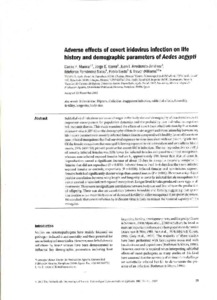Adverse effects of covert iridovirus infection on life history and demographic parameters of Aedes aegypti.
Marina Fernández, Carlos F. y Ibarra, Jorge E. y Arredondo Jiménez, Juan Ignacio y Fernández Salas, Ildefonso y Liedo, Pablo y Williams, Trevor
(2003)
Adverse effects of covert iridovirus infection on life history and demographic parameters of Aedes aegypti.
Entomologia experimentalis et applicata, 106 (1).
pp. 53-61.
![[img]](http://eprints.uanl.mx/1346/1.hassmallThumbnailVersion/Adverse_effects_of_covert_iridovirus_infection_on_life_history_and_demographic_parameters_or_Aedes_aegypti.pdf)  Vista previa |
|
PDF
Adverse_effects_of_covert_iridovirus_infection_on_life_history_and_demographic_parameters_or_Aedes_aegypti.pdf
Download (795kB)
| Vista previa
|
Resumen
Sublethal viral infections can cause changes in the body size and demography of insect vectors, with important consequences for population dynamics and the probability that individual mosquitoes will transmit disease. This study examined the effects of covert (sublethal) infection by Invertebrate iridescent virus 6 (IIV-6) on the demography of female Aedes aegypti and the relationship between key life history parameters in covertly infected female insects compared with healthy ( control) insects or non-infected mosquitoes that had survived exposure to virus inoculum without becoming infected. Of the female mosquitoes that emerged following exposure to virus inoculum and were offered blood meals, 29% (43/150) proved positive for covert IIV-6 infection. The net reproductive rate ( R 0) of covertly infected females was 50% lower for infected females compared to control mosquitoes, whereas non-infected exposed females had an R 0 approximately 15% lower than that of controls. Reproduction caused a significant decrease of about 13 days in mosquito longevity compared to females that did not reproduce (P < 0.001). Infected females lived 5-8 days less than non-infected exposed females or controls, respectively (P = 0.028). Infected females and non-infected exposed females both had significantly shorter wings than control insects ( P < 0.001). There was a significant positive correlation between wing length and longevity in covertly infected female mosquitoes but not in control or non-infected exposed mosquitoes. Longer lived females produced more eggs in all treatments. There were no significant correlations between body size and fecundity or the production of offspring. There was also no correlation between fecundity and fertility, suggesting that sperm inactivation was a more likely cause of decreased fertility in older mosquitoes than sperm depletion. We conclude that covert infection by iridescent virus is likely to reduce the vectorial capacity of this mosquito.
| Tipo de elemento: |
Article
|
| Materias: |
Q Ciencia > Q Ciencias en General |
| Divisiones: |
Ciencias Biológicas |
| Usuario depositante: |
Admin Eprints
|
| Creadores: |
| Creador | Email | ORCID |
|---|
| Marina Fernández, Carlos F. | NO ESPECIFICADO | NO ESPECIFICADO | | Ibarra, Jorge E. | NO ESPECIFICADO | NO ESPECIFICADO | | Arredondo Jiménez, Juan Ignacio | NO ESPECIFICADO | NO ESPECIFICADO | | Fernández Salas, Ildefonso | ifernand1@hotmail.com | NO ESPECIFICADO | | Liedo, Pablo | NO ESPECIFICADO | NO ESPECIFICADO | | Williams, Trevor | NO ESPECIFICADO | NO ESPECIFICADO |
|
| Fecha del depósito: |
26 Ene 2011 15:38 |
| Última modificación: |
08 Feb 2016 22:42 |
| URI: |
http://eprints.uanl.mx/id/eprint/1346 |
Actions (login required)
 |
Ver elemento |


 Descargar estadísticas
Descargar estadísticas Descargar estadísticas
Descargar estadísticas

